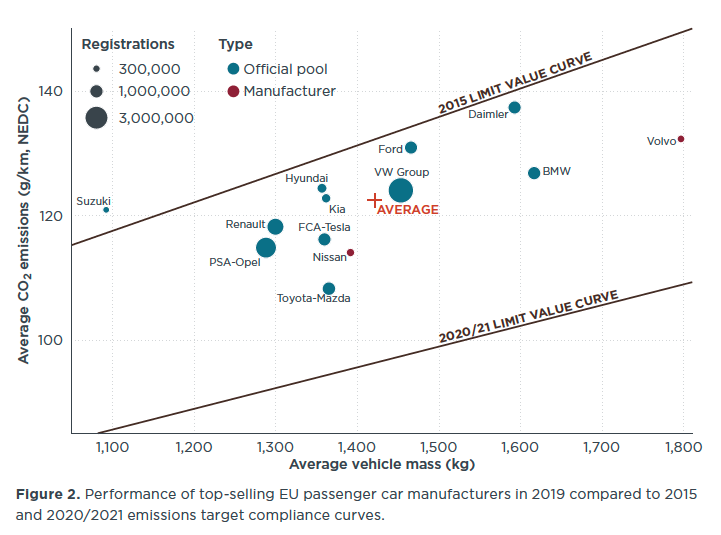Briefing
CO2 emissions from new passenger cars in Europe: Car manufacturers’ performance in 2019
This briefing paper provides an overview of CO2 emission levels of new passenger cars in the European Union (EU) in 2019 based on a preliminary dataset recently released by the European Environment Agency (EEA). The dataset showed that new cars sold in the EU in 2019 had average CO2 emissions of 122 g CO2/km, 1 g/km higher than in 2018, as measured over the New European Driving Cycle (NEDC). As of 2019, fleet-average CO2 emissions will have to decline by 11.9% per year to comply with the 2021 target.
Diesel market shares have continued to fall, from 36% in 2018 to 31% in 2019. Electrified powertrains generally gained ground during the same time period: hybrid-electric vehicles (HEVs) grew from 3.4% to 3.7%; plug-in hybrid electric vehicles (PHEVs) remained stable at 1.2%; battery electric vehicles (BEVs) grew from 1.3% to 2.2%; and mild hybrid-electric vehicles grew from 0.4% to 2.0% of registrations in 2019. Other powertrains, predominantly compressed natural gas and liquified petroleum gas vehicles, accounted for 1.6% of the market.
Norway continues to dominate the European electric vehicle (EV) market, with 42.4% of new car registrations in 2019 being BEVs and another 13.6% being PHEVs. Within the EU, the Netherlands (13.8% BEV and 1.2% PHEVs) and Sweden (4.4% BEVs and 7.0% PHEVs) saw the highest uptake of electric vehicles. Shares of hybrid-electric vehicles (HEVs) were particularly high in Norway (11.4%) and Finland (11.0%). Italy was the major EU market with the highest diesel share despite a 9-percentage-point drop from 2018 to 2019. Italy also was the only market with a significant share of compressed natural gas and liquified petroleum gas vehicles.
The share of new passenger cars with eco-innovation technologies installed has increased over time, most recently from 5% in 2018 to 12% in 2019. The average CO2 emission reduction in vehicles that had eco-innovations installed was 1.6 g/km in 2019. For individual vehicles, the maximum recorded CO2 emission reduction from eco-innovation technologies was 9.2 g/km in 2019.
There are a number of factors that will affect manufacturers’ compliance with the 2020/21 CO2 targets, including further improvements in combustion engine vehicles, growth in the hybrid electric vehicle market, the introduction of new electric vehicle models, and an increase in the use of eco-innovation credits.

